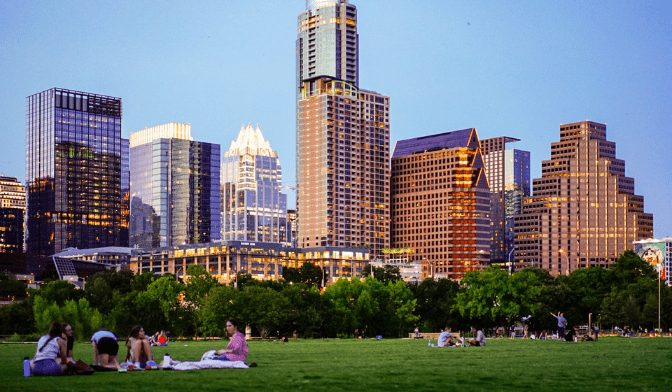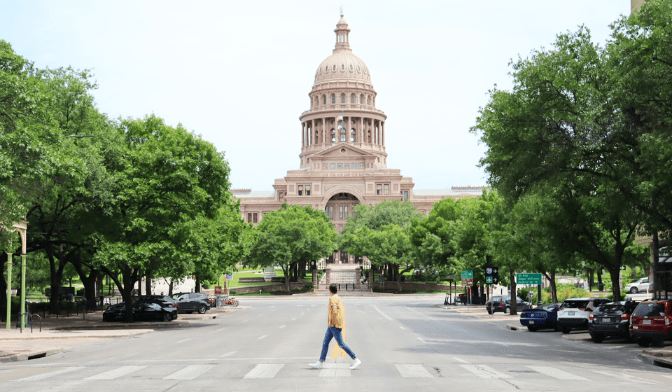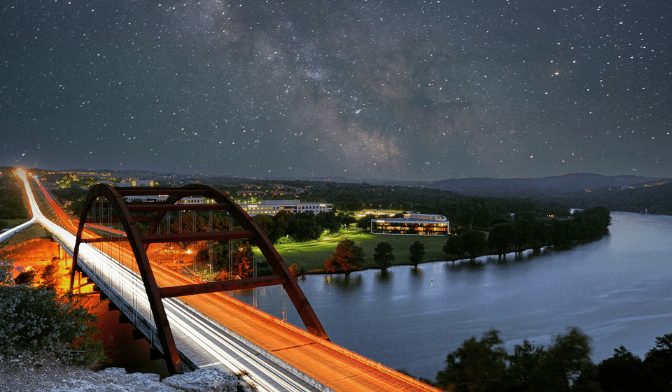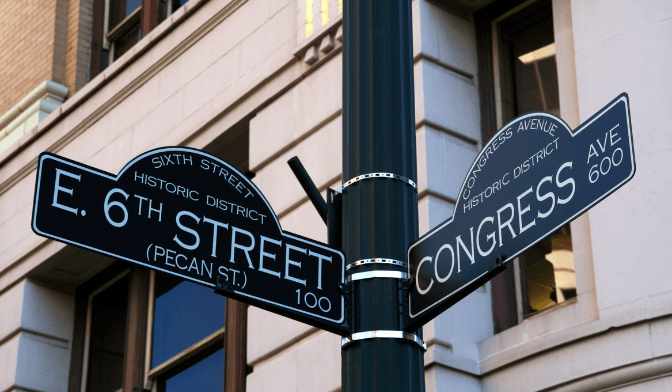Outside Austin City Limits: The moveBuddha 2022-2023 Austin Migration Report

Austin is still America’s fastest-growing metro area by many standards. According to Census figures, the Austin MSA population swelled by a staggering 84% between 2000 and 2020. Austin saw a flurry of in-flow moving interest in the early pandemic migration boom. But moveBuddha’s recent data shows the interest may be waning, and outward migration is ticking up. That’s especially the case in Austin’s downtown areas, driven mainly by rapidly rising housing prices.
Big Takeaways:
- Austin is still growing, but not like it was before. The Austin MSA’s inflow-to-outflow ratio hit a high of 2.30 in January 2021, but it’s been downhill ever since. Searches to move into the Austin area even hit the negative territory in parts of late 2022.
- Austin’s suburbs are the most popular. 4 of the top 5 zip codes in the Austin MSA in 2022 that saw the most move-in search volume were outside the city limits, including Leander, Liberty Hill, and Georgetown.
- California transplants keep on coming. Yes, it’s true – the cities that show the most interest in moving to Austin remain in California. Though the volume slowed down last year, San Francisco and San Jose residents were the most interested among all major U.S. city dwellers in moving to Austin.
Priced-out: Austin’s Keeping it Weirdly Expensive
We’ve all seen the headlines about the Austin MSA’s explosive growth. The Central Texas city nestled in the Hill Country has become a hotbed for tech startups, as well as maintaining its status as the “Live Music Capital of the World.” It’s also one of America’s most financially healthy metro areas.
But according to recent data from moveBuddha, outward migration from the Austin MSA is surprisingly seeing an uptick. Austin and Texas cities were big winners of the early pandemic migration boom, but it may be slowing down.
The Austin area’s move-in-to-move-out ratio reached a high of 2.30 in January 2021 but has nose-dived since June 2022, according to moveBuddha data. The inflow-to-outflow ratio of searches for moves into Austin hit the negative territory in September 2022 (0.94) and ended last year at 1.26, a far cry from the gaudy positive numbers from early 2021.
A primary reason for this slowdown in interest in moving to the Austin area may be the fast-rising cost of living and housing prices. The U.S. Department of Housing and Urban Development says Austin is the most expensive city to build a new home in the Lone Star State. The National Low Income Housing Coalition also ranks Texas as one of the nation’s worst states for affordable housing.
Let’s take a closer look at the moveBuddha data to determine the timeline of move-in interest to Austin and which zip codes are seeing the most interest.
Table of Contents:
I. Austin Timeline – Timeline of searches for moves
II. Austin Neighborhood Trends
III. City-to-City Moving Trends
IV. Methodology
I. Timeline of Moves to and from Austin: A Central Texas Cool-Down

The interest in moving to the Austin MSA was prominent early in the pandemic. You probably remember everyone talking about the moves to the Lone Star State and Austin, and the hype surrounding it is indeed backed up with hard data.
From January 2020 to July 2021, the Austin MSA saw robustly positive search volumes for moving into the area. A month after the pandemic hit the U.S. (April 2020), the inflow-to-outflow ratio for Austin was a healthy 2.65. And then, from September 2020 to February 2021, the ratio was over 2.0 each month. This means that for every 100 people who searched for moves out of Austin in moveBuddha’s moving calculator, another 200 were searching for moves in.
There were likely several reasons for this. Major companies like Tesla fled California for Central Texas, taking workers with them. Texas’ low corporate taxes, no state income tax, and minimal business regulations made it a magnet for Silicon Valley tech firms and startups.
It also helps that Austin has a reputation as a fun, culturally diverse, and vibrant city. “Keep Austin Weird” is an unofficial motto, and the city’s rep has drawn young professionals and digital nomads who were free to work wherever they wanted, thanks to the surge in remote work during the pandemic.
But according to moveBuddha data, the halcyon days of Austin’s migration interest are slowing down considerably. Since August 2021, the search volume for moves into the Austin MSA has trended downward.
In two months in 2022 (July and September), the search volume inflow-to-outflow ratio was negative, meaning more people were considering moving out of Austin than in. The Austin MSA finished the year in December 2022 with a move-in-to-move-out ratio of 1.26.
II. Austin Moving Trends

The interest in moving into Austin slowed in 2022, but some suburban areas in the Austin MSA continued to be hot spots. Many Austin city zip codes saw negative inflow-to-outflow ratios in search volume last year, but suburbs like Leander, Georgetown, and San Marcos stayed attractive for many.
Packing up for the ‘burbs
Analyzing moveBuddha search data, we found which zip codes have the highest proportion of moves out vs in and the inverse. Only zip codes with 25 moves in and out were considered for this analysis (38 zip codes).
Top 5 zips to move to in Austin in 2022:
| Zip Code | Neighborhood | In/Out Ratio |
| 78701 | Austin | 2.06 |
| 78641 | Leander | 1.96 |
| 78642 | Liberty Hill | 1.82 |
| 78633 | Georgetown | 1.65 |
| 78626 | Georgetown | 1.59 |
Top zips to move out of in Austin in 2022:
| Zip Code | Neighborhood | In/Out Ratio |
| 78751 | Austin | 0.34 |
| 78754 | Austin | 0.49 |
| 78703 | Austin | 0.50 |
| 78757 | Austin | 0.51 |
| 78729 | Jollyville | 0.53 |
The 78701 Austin zip code had the most positive search volume last year, but this is probably because it’s a default zip that out-of-towners search for. The biggest winner in the Austin MSA in 2022 was Leander (78641), which had a move-in-to-move-out ratio search volume of 1.96.
Located just north of Austin, Leander was the fastest-growing city in all of America between 2018 and 2019, according to the U.S. Census Bureau. The growth hasn’t slowed down recently. Leander’s population was 59,202 in the 2020 Census and 67,124 in the 2021 Census estimate, quite the increase.
Why is Leander growing by leaps and bounds? One big reason for Leander’s explosive growth may be access to the CapMetro Commuter Rail, which makes getting into and out of downtown Austin much easier.
MetroRail’s northern terminus is located in Leander, and the surrounding area is what’s referred to as a “Transit Oriented Development Area.” That makes it a prime location for real estate and business development.
Meanwhile, Austin city zip codes have fared much worse since 2020. Several Austin codes (including 78727 and 78754) had negative search volume ratios in 2020. In 2022, all but one zip code (Jollyvile) that landed at the bottom for search volume was located in Austin’s city limits. The moveBuddha data makes clear that people are more interested in Austin’s suburbs than city living.
III. Which Cities are Moving to and from Austin?

- Yes, the California exodus to Austin is happening. A surge of move interest from San Francisco, San Jose, Los Angeles, and even San Diego into Austin has remained steady from 2020 through 2022.
- Denver has been a thorn in Austin’s side. From 2020 through 2022, Austin residents have consistently been interested in moving to Denver.
- Heading back to NYC. Austin gained sizeable moving interest from New York City in 2020 and 2021, but the trend reversed in 2022. More Austin folks were considering a move to the Big Apple last year than New Yorkers were thinking about moving to Austin.
Californians really do love Austin
As the inflow migration interest in Austin has waned since 2020, move-in interest from dwellers of other major American cities has, too. Nevertheless, the intensity of interest in Austin from some U.S. city residents in 2020 and 2021 was high.
Consider that in 2020, the search volume move-in to the move-out ratio for San Francisco residents for Austin was a staggering 12.13. That means that for every 100 Austin residents who considered moving to San Fran in 2020, another 1,213 San Francisco folks were thinking about an Austin move.
San Jose residents in Silicon Valley were also hot for Austin in 2020, with a search move-in to the move-out ratio of 8.0. The ratios of both SF and San Jose have cooled down considerably since then, but they were still positive in 2022. Austinites are probably still seeing many California transplants.
A 2022 reversal in move-in interest
2022 was a different story for Austin regarding move-in interest from major U.S. city residents. Of the 21 cities we studied, only 13 had positive inflow-to-outflow search volume interest in 2022, a big change from 2020 and 2021. Some cities that were wild about Austin in 2020 changed their tune in 2022, including Atlanta, New York City, Brooklyn, and Washington, D.C.
Here are the top cities moving into Austin in 2022 (cities with the highest ratio of moves into Austin):
- San Jose, California
- San Francisco
- Chicago
- Nashville
- Houston
Austin exit cities in 2022 (Cities with the highest ratio of moves exiting Austin):
- Denver
- New York City
- Portland, Oregon
- Washington, D.C.
- Raleigh, North Carolina
On the road to the Mile High City
One last thing that’s interesting to note is that Denver has consistently been a city that has gained the most move-in interest from Austin residents since 2020.
For two out of the last three years, Denver has seen the most interest as a moving destination for Austinites out of any U.S. city. This seems to make sense on several levels. Denver and Austin are similar cities and politically progressive outposts in traditionally conservative areas with great access to the outdoors, thriving local music scenes, and “weird” vibes. Just Google the artwork and murals at the Denver International Airport, and you’ll see what we mean.
For whatever reason, many Austinites who may be planning a move out of Central Texas are looking at The Mile High City as their next landing spot.
Is Austin Losing its Groove?

Move-in interest to Austin was as hot as the Texas sun in 2020 and 2021, but a cool-down could be developing. That doesn’t mean it’s all bad news for the Austin metropolitan area, though. Austin is still one of the fastest-growing cities in America, and even if the pace slows down, the metro area is expected to keep adding residents well into the future.
Austin has become a hotbed for the tech industry, recently becoming home to major firms like Amazon, Tesla, Oracle, and Google. The weakening economy has led to tech layoffs, but the pain hasn’t been felt as widely in Austin. The top 50 tech firms in Central Texas have added more than 8,200 employees in the past year, according to the Austin Business Journal. “We’re not seeing a lot of pain yet in Austin,” Thom Singer recently said, the CEO of the Austin Technology Council.
The primary problem Austin seems to be facing is that the cost of living, especially housing, continues to skyrocket. Housing affordability was a central issue in the recent Austin mayoral race, and the reason the area may be seeing an uptick in move-outs is that working-class people are getting priced out.
Native Austinites may be among those searching for cheaper locales throughout the U.S. If Austin wants to keep growing and stay equitable (and weird) for all its citizens, the cost of living will have to be addressed. Otherwise, the slowdown in move-in interest to Austin we’ve seen at moveBuddha could accelerate and put a damper on one of America’s fastest-growing metro areas.
IV. Methodology and Sources
Data used in this report spans from January 2020 through December 31, 2022, capturing searches by individuals who were either planning to move themselves or hire a moving company in the subsequent year.
We used this data to analyze:
Section I: Timeline of moves into Austin MSA
- Moves into Austin MSA zip codes
- Moves out of Austin MSA zip codes
- Mover search data was collected from Jan 1, 2020, through December 31, 2022, by zip code.
Section II: Austin MSA Moving Trends
- The in-to-out ratio is calculated by dividing the number of searches for moves in by the number of searches for moves out.
- 2022 mover search data was collected from Jan 1, 2022, through December 31, 2022, by zip code.
Section III: Which U.S. Cities Are Moving to and from Austin MSA?
- The in-to-out ratio by the city is calculated by dividing the number of searches for moves into Austin MSA from a city by the number of searches for moves out of Austin MSA to the same city.
- Cities included in this analysis had a minimum of 25 searches for moves into Austin MSA and 25 searches for moves exiting Austin MSA to the same city in 2022.
- Mover search data was collected from Jan 1, 2020, through December 31, 2022.
Not what you were looking for?
Check out other categories that can help you find the information you need!

